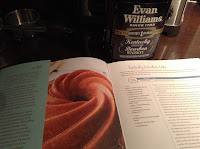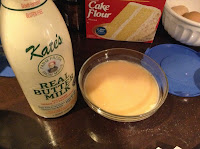
 I went away for my semi-annual Quilt Weekends on the Cape with old friends (somewhere around our 25th year.) I don't know if I have ever picked dessert before, to be honest. I usually like to cook brunch or dinner ... or even appetizers.
Dessert means two - one for each night. And Friday night's had to be ready to go Friday morning. The Kentucky Bourbon Cake seemed like a natural choice. It actually becomes more delicious with time, I think.
For Saturday night's dessert I chose to explore two books by bakers Matt Lewis and Renato Poliafito: Baked Explorations (2010) and Baked Elements (2012). Despite some of the professional cook snobbery* (what cookbook doesn't preach to me these days!), I poured through both of them and settled on an Orange Creamsicle Tart in their first book. I wanted to get out of the 'cake thing' that I've been in lately and I have loads of assorted tart pans. I assembled the tart in the kitchen in Falmouth (bringing the tart crust prebaked.) I have to say that I wouldn't make this dessert again. It was yummy but it would need a very hot summer night, I think. It was tart and the crust was crispy like a cookie and actually tasted a bit like Key Lime.
I went away for my semi-annual Quilt Weekends on the Cape with old friends (somewhere around our 25th year.) I don't know if I have ever picked dessert before, to be honest. I usually like to cook brunch or dinner ... or even appetizers.
Dessert means two - one for each night. And Friday night's had to be ready to go Friday morning. The Kentucky Bourbon Cake seemed like a natural choice. It actually becomes more delicious with time, I think.
For Saturday night's dessert I chose to explore two books by bakers Matt Lewis and Renato Poliafito: Baked Explorations (2010) and Baked Elements (2012). Despite some of the professional cook snobbery* (what cookbook doesn't preach to me these days!), I poured through both of them and settled on an Orange Creamsicle Tart in their first book. I wanted to get out of the 'cake thing' that I've been in lately and I have loads of assorted tart pans. I assembled the tart in the kitchen in Falmouth (bringing the tart crust prebaked.) I have to say that I wouldn't make this dessert again. It was yummy but it would need a very hot summer night, I think. It was tart and the crust was crispy like a cookie and actually tasted a bit like Key Lime.Always leave your ingredients out until they are room temperature.
For the Orange Tart Dough:
Beat 1/2 cup softened butter, 14 cup sugar, zest of one orange (about 2 T) and 14 tsp. salt until light and fluffy. Add one egg and beat until just incorporated. Scrape down the bowl, add 1-1/2 cups flour all at once and quickly beat until the dough comes together in a ball. (I did this by hand because you don't want to overbeat and make a hard crust.)
I then took that ball and picked it up with a hand that was holding the outside of a thin plastic bread bag. Mold the dough into a flat circle as wide as you can and refrigerate for at least 1/2 hour. Freeze for the first ten minutes if you'd like. Remove the dough from the bag and using a floured rolling pin on a floured surface, roll the dough to a circle 1 inch wider than your tart pan. Press it into place. Place the tart pan into the freezer.
Line the pan with aluminum foil and cover the foil with pie weights or dried beans. Bake for 15 minutes, remove foil and weights and bake for another 10 minutes. Transfer it onto a wire rack to cool.
For the Orange Cream Soda Filling:
First, cut 1/2 cup butter into cubes and set aside. Then zest and juice two lemons and three oranges.
Sprinkle 1-1/4 tsp. unflavored gelatin over juice of two lemons (1/4 cup) in a wide bowl.
In a medium saucepan, stir together the juice of 3 large oranges (1 cup) and 1 cup of orange cream soda. Bring it to a boil and cook until it is reduced by 1/2 (or 1 cup of liquid remaining.) Turn the heat to low and whisk it to release the heat.
In a medium bowl, whisk together the zest of the two lemons and three oranges, 3 large eggs, 2 egg yolks and 3/4 c. sugar and place in a saucepan. Cook over medium-low heat, whisking constantly, until a candy thermometer reads 180 degrees F - or the curd can easily coat the back of a wooden spoon.
Remove the pan from the heat and add the lemon/gelatin mixture. Whisk until the gelatin is completely combined. Pour the liquid through a fine mesh sieve directly onto 1/2 cup. butter that has been cut into cubes. Whisk this furiously until it has increased a bit in volume. Cover the top of the curd with plastic wrap, pressing the plastic directly onto the surface and refrigerate at least four hours.
Beat the curd on high for 5 minutes and spoon it into the tart. Refrigerate for one hour.
Orange Whipped Topping
Pour 1 cup whipping or heavy cream into a chilled bowl and beat for 1 minute. Sprinkle with 2 T sugar and 2 T orange cream soda and beat until soft peaks form. Pour or spoon onto tart.
*I use PAM baking spray because it works great for me. The authors of Baked Explorations and Baked Elements call it 'that horrible baking spray.' Whatever works.







.JPG)
.JPG)